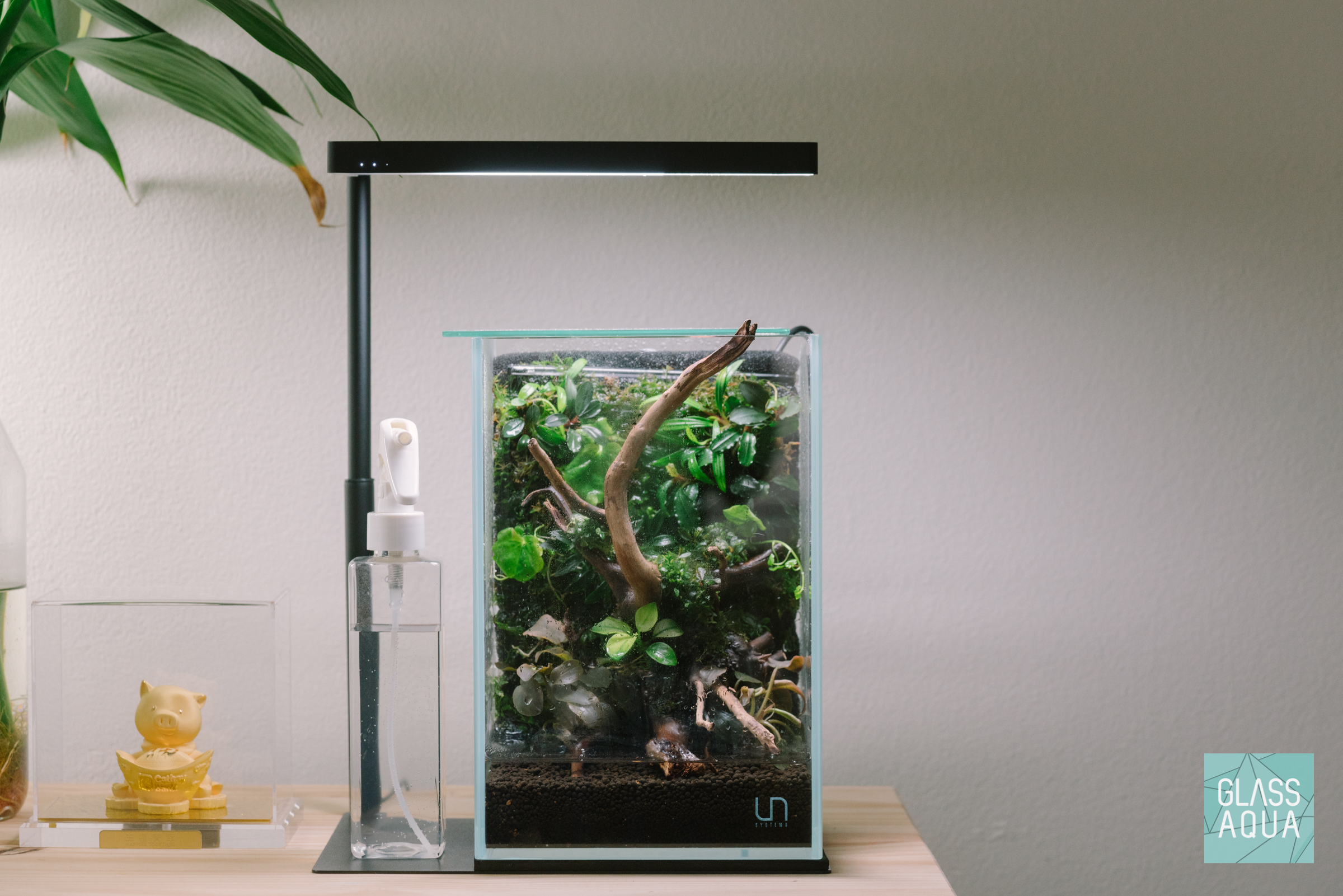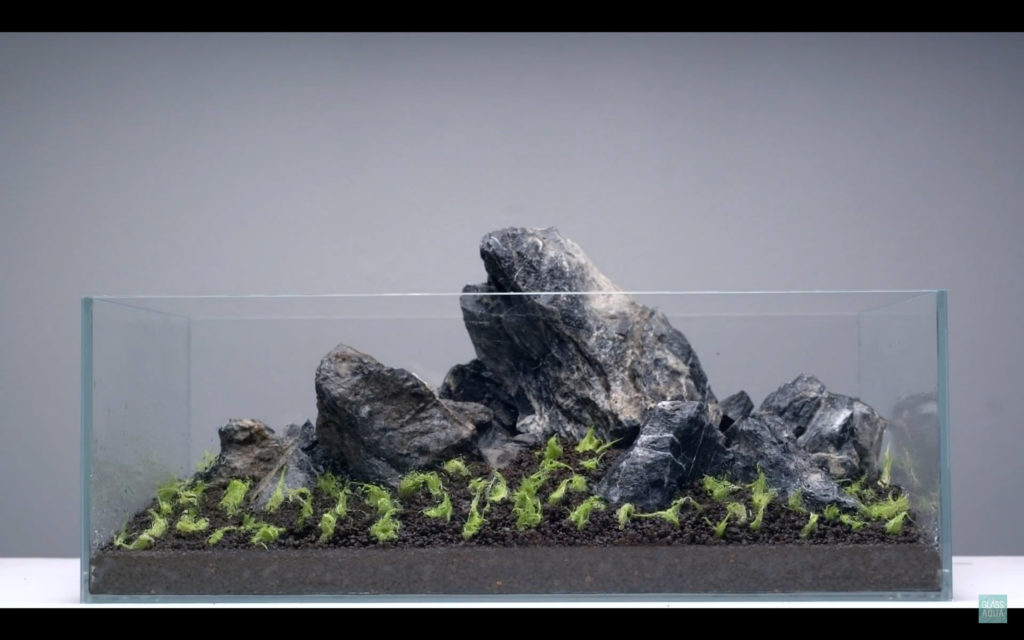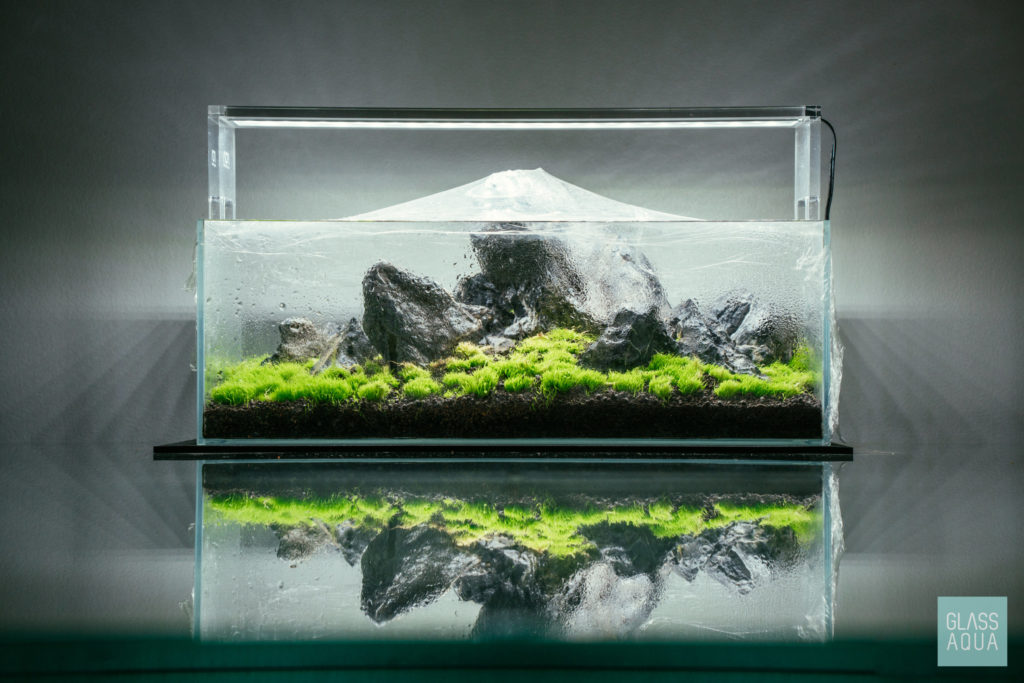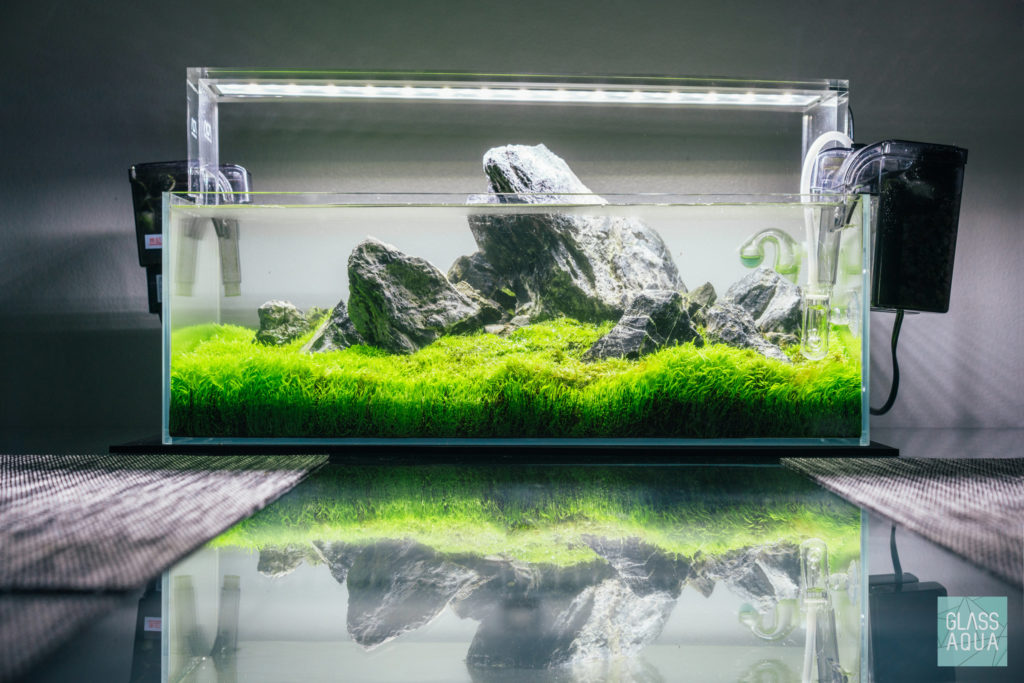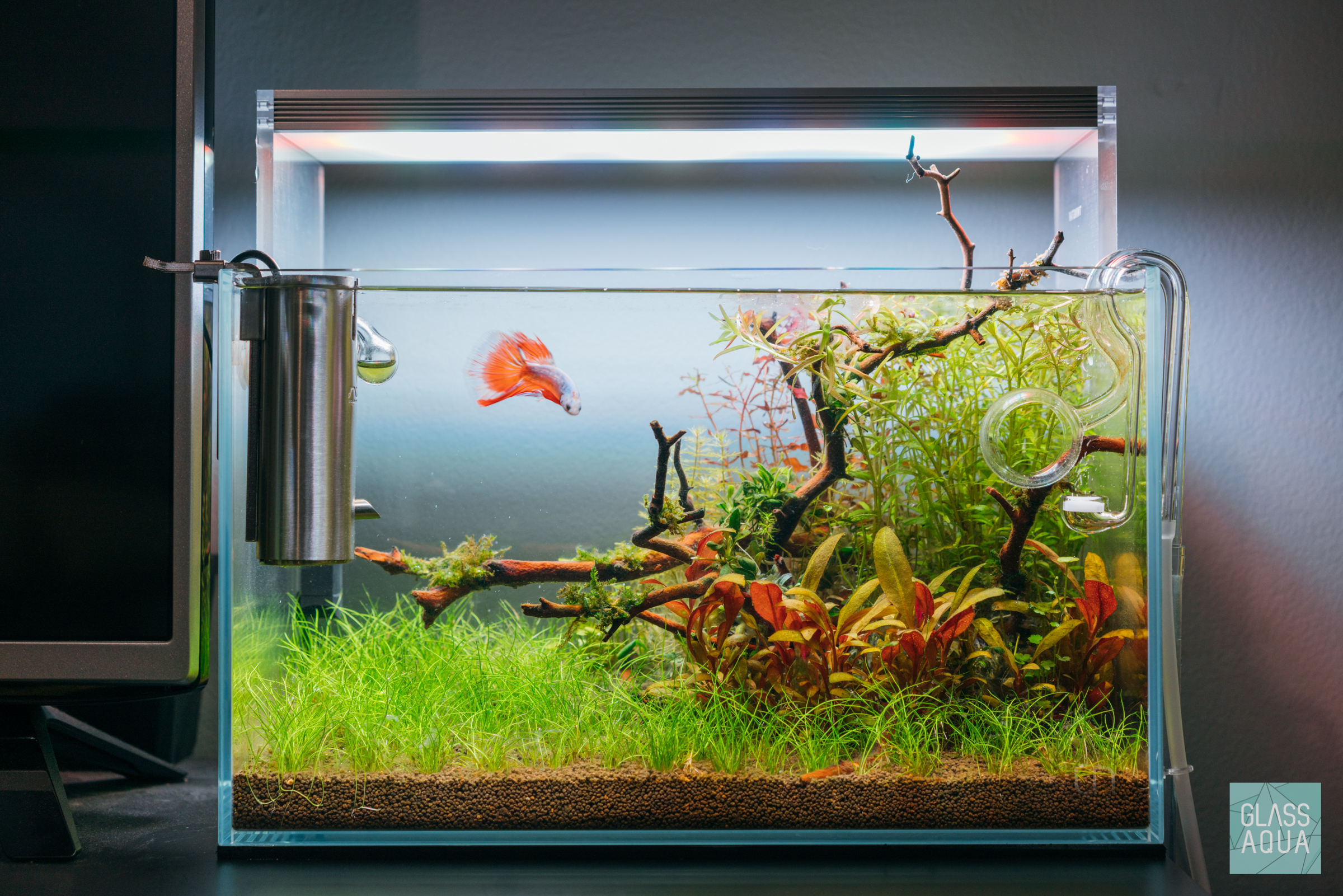Throughout recent years of the planted aquarium tank hobby, many have wanted to try the Dry Start Method or DSM for short. It’s not as difficult as it’s made out to be nor is it by any means highly technical at all. The greatest benefit, that we can think of that this method provides is giving extra time to source all the initial equipment such as filters, heaters, CO2 equipment that is needed in order to flood/fill a planted tank.
So what do I need in order to Dry Start?
The basic necessities needed in order to accomplish a Dry Start in a planted aquarium are as follows:
- Aquarium tank
- High-quality substrate of your choosing. We’ve had great success with Ultum Nature Systems x Marfied Controsoil and Tropica Aquarium Soil.
- Hardscape materials
- Tweezers such as Ultum Nature Systems Stainless Steel Aquascaping Tool Set
- Mister bottle with clean water
- Clear Saran Plastic Wrap
- The light fixture you will be using for your tank
- Plug-in timer (optional if you are able to manually turn lights on and off consistently)
- Aquatic plants. We recommend DSM for foreground plants such as Glossostigma Elantinoides, Eleocharis Parvulus AKA Hairgrass, Hemianthus Callitrichoides ‘Cuba’ AKA Dwarf Baby Tears, Micranthemum ‘Monte Carlo’, Utricularia Graminifolia AKA UG, etc.
Where do I begin?
Start by adding in your hardscape and planted tank substrate soil. We recommend a high-quality substrate in this case since during the Dry Start period, no fertilizers will be added and the substrate itself will be the only access to nutrients aquatic plants will have during this stage. Spraying liquid fertilizers during this time will promote algae/mold growth and is an unnecessary waste of fertilizers. Make sure that you are happy with your final look as once the aquatic plants are added and start growing in, it is best not to disturb the layout or soil at all. Next, mist the substrate soil until it is thoroughly moist, not flooded, but moist enough so that the top of the soil all the way to the bottom of the substrate is visibly wet. You can see this happening through the aquarium tank. Most substrates will darken in color once wet. If puddles start to form, this is the best visual sign that the substrate is too wet for your DSM to succeed. Use clean paper towels to soak excess water. This beginning step is extremely crucial to a successful DSM.
What happens if my substrate is too wet?
Starting the DSM with overly wet substrate creates too much humidity leading to the number one cause of a failed Dry Start, mold. Mold, similar to algae, can and will rapidly overcome your aquatic plants and aquarium. This will smother the plants and ultimately cause them to wither or rot away. At this point, it is required to either treat the mold and try to salvage the healthy portions of aquatic plants, or start flooding the tank prematurely. Flooding the aquarium prematurely will only mean all the time spent on the DSM would have been for naught.
How do I “salvage” aquatic plants during the DSM if I have mold problems?
Treat with 3 parts Hydrogen Peroxide to 1 part water. However, the success rate is low and overdosing on Hydrogen Peroxide may weaken the aquatic plant itself. Otherwise, we recommend restarting the Dry Start or flooding the tank immediately. However, the catch at this point is making sure to have the proper equipment on hand needed to flood a planted aquarium such as a filter, heater, CO2 equipment, etc.
Okay, I misted correctly and the soil looks wet and there are no visible puddles, what’s next?
Now it’s time to plant your plants. As we mentioned, the DSM works exceptionally well with carpeting aquatic foreground plants. In our experience with this method, we chose to Dry Start Utricularia Graminifolia or UG. This plant is widely known to melt and wither away in a planted aquarium that is immediately flooded. If you plan on planting aquatic stem plants or attaching Epiphytes such as Anubias species, Java Fern or Bolbitis, we recommend planting them when the DSM is complete, right before flooding.
Why does Dry Start Method work better for carpeting foreground plants?
The DSM works so well because the aquatic plant is actually grown emergent and has plenty of access to CO2 from the air we (and everything else) breathe out. There is much more CO2 access in the open environment than there is underwater no matter how much CO2 is injected.
Using the Dry Start Method essentially makes CO2 plentiful and easily accessible while transitioning the aquatic plant slowly. Given this fact, in our opinion, one can also technically plant and grow aquatic stem plants and Epiphytes via the DSM, but since the DSM is essentially encouraging emergent growth, aquatic stem plants will convert to its emergent form and will have a tougher time transitioning back to its aquatic form soon after flooding the aquarium. Another note to keep in mind is some aquatic stem plants have the possibility of being burned or dried out by the light fixture if they are planted too high or grow too tall. In terms of Epiphytes, most are grown in tropical regions where the humidity is much higher than is needed in a DSM setup and will most likely dry out and perish in a typical DSM aquarium. Remember, higher humidity only encourages and promotes mold growth. This is why many Epiphytes that you see in a planted aquarium are also used in high humidity and humidity regulated Terrarium and Paludarium setups. Aquatic foreground plants do so well in a DSM setting simply due to the fact that they stay relatively low and will develop a healthy root system that will make the transition to submerged form a lot quicker and easier.
Now that I’ve planted my aquatic plants what do I do?
We suggest misting the aquatic plant tops to ensure that they are not dry. Then proceed to tightly wrap the top of the aquarium tank with Saran wrap without any holes or openings. This is the second most important factor to a successful Dry Start. Next, turn on your light fixture and set it on a timer for 12 hours a day. There are numerous articles online that have stated different light cycle times; however, we have had the most success with 12 hours.
Do I need to do anything else?
You must commit 30 minutes a day to lift and open the Saran wrap for proper CO2 exchange for your aquatic plants to breath in. Lift the Saran wrap open for this to occur. A single 1 – 2 inch opening will be enough for most planted tanks up to 10 gallons. Remember to only let this exchange occur for 30 minutes otherwise, the aquatic plants will dry out or weaken. A caveat to this step is that depending on your location and climate, your DSM tank may need to be misted more often than others located elsewhere, so YMMV in this case. Another indication of the moisture level is if condensation builds up against the walls of your aquarium then the DSM is still in effect.
My DSM is going great, I’m starting to see new roots and growth, what do I do?
Root growth and carpeting runners are an obvious good sign and a signal that the DSM is proceeding accordingly. However, remember to mist it based on the visual cues. If the lower levels of substrate are starting to dry, it’s time to mist. If it’s still wet and moist, then sit back and enjoy the growth!
How long do I need to continue on with the DSM?
Almost all aquatic plants will grow exponentially quicker using the DSM. Depending on the aquatic plants used, some choose to flood the tank after a few weeks time while others patiently wait until a full carpet of aquatic plant is formed. The choice is yours. Once the plant is heavily rooted and spreading, the opportunity to flood has come.
This seems too easy, are there any downsides?
There are no downsides to the DSM that we have experienced. It’s the perfect method to use when all the equipment required to flood your tank is not readily available.
I just flooded my DSM, do I need to do anything else? Or can I just sit back and enjoy my fully planted aquarium?
The DSM should only be seen as a quick way to fill in your planted aquarium with aquatic plants. Once the tank is flooded, regular care is still required the same as if the planted aquarium was flooded on day one. This includes CO2 injection, a regular lighting schedule, fertilization, water changes and overall maintenance. The DSM should not be viewed as a way to have a fully planted tank that does not require care after the fact.
Any tips that you can give me once the tank is flooded?
We highly recommend the light schedule to be decreased to 6 hours initially with a gradual bump to a maximum of 8 – 10 hours depending on your setup along with a slight excess of CO2 injection to help speed up aquatic plant growth and emergent to submerged transition. We recommend using a glass drop checker with a good pH monitoring solution for a visual guide. Most carpeting foreground aquatic plants will transition rather swiftly. In addition, we recommend regular and frequent water changes to help prevent or inhibit any algae problems that may occur during this stage. After the aquatic plants are fully transitioned and growing underwater, the light schedule can be increased while the CO2 injection can be slightly decreased and ready for new aquarium inhabitants.
Below is a gallery of progression that our Instagram friend @midorium.us sent to us after we provided her with the exact same DSM as mentioned above.
We hope that this article about the Dry Start Method has been informative and useful. The opinions expressed in this article are ours alone based on our personal experiences. Due to the varying nature of planted tanks, please do your due diligence before entertaining the DSM and please do feel welcome to send us an email, DM or message via our social channels if you would like our input on this topic.





